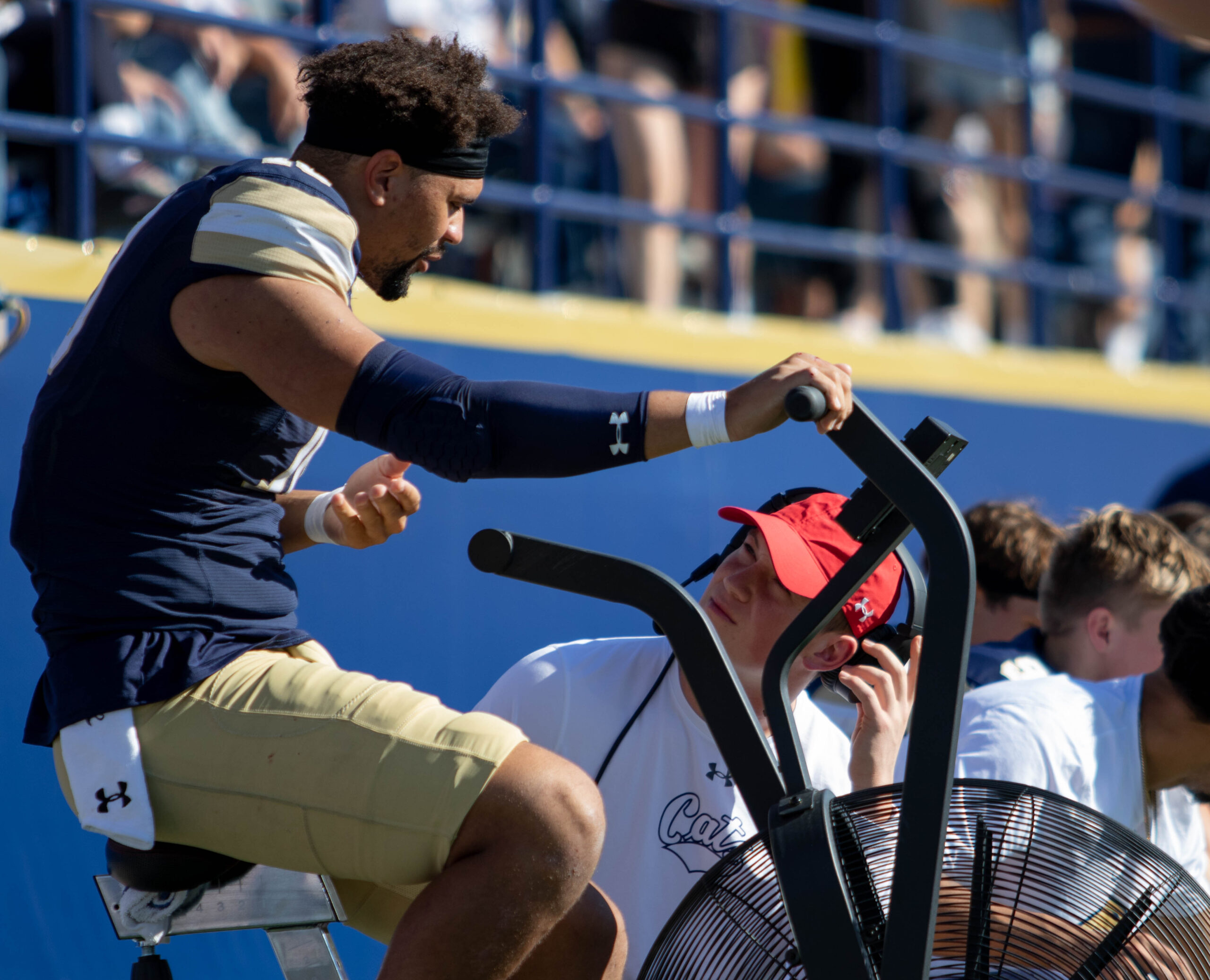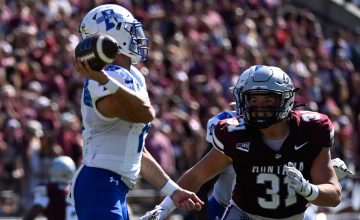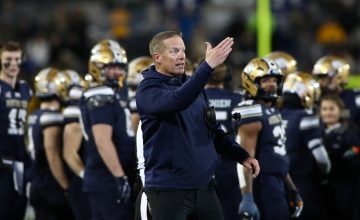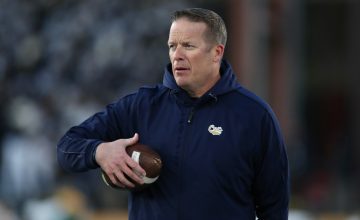Every week, we’ll cover every game from around the Big Sky, going beyond the box score with analysis and thoughts on every team.
This week on the Big Sky Scramble: we’re halfway through the season, and stats are starting to stabilize and become real rather than just small-sample-size mirages. Here’s one stat that jumped out at me from every team.
– Sacramento State unsurprisingly rolled Northern Colorado 55-7 in Sacramento. The standout stat for the Hornets is not Cameron Skattebo’s eight yards per carry, which has held steady through five games now. It’s Asher O’Hara’s 5.1 yards per carry, which is the worst mark among Sac State’s three primary ballcarriers (Skattebo is at eight on 67 carries, Marcus Fulcher is at six on 31 carries, O’Hara is at 5.1 on 65). Actually, it’s the worst among any Sac State player besides tight end Marshel Martin and wide receiver Carlos Hill (who have one carry apiece) and passing quarterback Jake Dunniway.

Skattebo and O’Hara get the headlines, but that quality showing no matter who’s running the ball shows that the Hornets’ offensive line isn’t getting enough love. They’ve also allowed only eight sacks through five games. Being able to rip off consistent gains no matter who’s carrying the ball has also helped Sac State keep Skattebo fresh – he’s got 67 carries, fewer than other bell-cow backs like UC Davis’s Ulonzo Gilliam, Northern Colorado’s Elijah Dotson and Weber State’s Josh Davis.
Here’s another stat: the Hornets have never trailed this season, which lets that rushing attack control games and put them away. Game stats are a bigger thing in soccer than they are in American football, but Sac State reminds me of prime mid-decade Barcelona – get behind them, and they’re perfectly built to not ever let you get back in the game (Barca because they’ll never let you have the ball, Sac State because they’ll just kill the clock and score every time without having to take risks with the ball in the air). You can’t play from behind against them – or, at least, nobody’s been able to do so thus far.
– In Greeley, Northern Colorado is one of only two teams in the conference to have two quarterbacks qualified for the league passing charts (Idaho State is the other – neither Sac State’s Asher O’Hara nor Montana State’s Sean Chambers have enough attempts). Dylan McCaffrey and Jacob Sirmon rank 11th and 12th, respectively, out of 14 players in the quarterback efficiency metric, and ninth and 14th, in the same order, in completion percentage. Not that finding an answer under center would have made the Bears a contender but, as I’ve pointed out before, that’s nine (9) combined recruiting stars worth of quarterbacks, and zero (0) above-replacement-level play.

– Speaking of replacement-level quarterbacks, I think the line this year is Miles Hastings of UC Davis, which didn’t play last week. Hastings is leading the league in passing yards per game with 252, completes 65 percent of his passes and has thrown eight touchdowns against four interceptions. That’s fine (it’s actually pretty good), and I think there are multiple teams in the conference for whom he would be an upgrade, but every contender has a better quarterback situation.
There just aren’t very many mediocre quarterbacks in the league this year; everybody is either a step above (Lucas Johnson, Sac State’s guys, Montana’s State’s guys, Bronson Barron (narrowly), Idaho’s Gevani McCoy, Portland State’s Dante Chachere, Eastern Washington’s Gunner Talkington) or several steps below (everybody else). The Aggies, like a team we’ll get to in the section below, have plenty of talent but their season is over thanks largely to their schedule – they have multiple one-score losses against top-10 teams and sit at 1-4.
– The Idaho stat of the season is clear so far – the Vandals are leading the conference in time of possession at 37:07 per game. That’s nearly three minutes clear of Montana State, one of the best rushing offenses in the country, and nobody else in the league is better than Sac State’s 31:17. Why the Vandals are that far ahead of everybody else is tough to explain. They’re not converting third downs at an unsustainable rate – in fact, they’re 10th in the conference with a 35.8% rate on third down. They’ve been willing to go for it on fourth down – a predilection I noted all the way back in the first edition of this column – and are 8 for 13 there, but that’s not an outlier number in either attempts or success rate (they’re fourth in both).
The answer is that Idaho’s offense stops the clock less than any other team. The Vandals have attempted just 134 passes, fewest of any team in the league, and quarterback Gevani McCoy is completing a league-high 72.8% of his throws. In fact, that’s a league-high by over five percentage points ahead of second-place Lucas Johnson. Never throw and never throw incomplete, and the clock is always running. As to how that will play into this week’s rivalry matchup against Montana? I think it will be very difficult to wear down Montana’s defense no matter how long you keep them out there, just because the Griz are so deep on that side of the ball. But if they put together some long drives, and avoid making mistakes, the Vandals could stop Montana’s offense from gaining any momentum.

– Weber State handled Eastern Washington, taking a 21-14 halftime lead and then throttling the Eagles in the second half for a 45-21 win. The Wildcats’ defense has been one of the best in the country by almost every metric, but I wonder if it could be even better. Weber State has secured 11 interceptions, including five by Maxwell Anderson, but has forced just three fumbles. Compare that to the other top defenses in the conference: Montana (eight), Montana State (10), Sac State (five) and Idaho (seven). Heck, compare it to the worst defenses in the conference: Northern Colorado (11), Eastern Washington (13) and Idaho State (14).
There’s not anything about Weber State in particular that would make the Wildcats less likely to force fumbles than anybody else, so if that luck evens out, the Wildcats could be creating even more big plays on defense.
– Eastern Washington is giving up an even six yards per rush and 281 rushing yards per game, by far the worst marks in the conference (Idaho State is next worst at 5.4 and 223). That’s skewed because the Eagles have played two Power 5 teams plus Montana State, but it’s fitting because, next to their schedule, their inability to stop the run is the biggest thing that’s doomed the Eagles to playoff irrelevance halfway through the year.
– Northern Arizona barely got back in the win column, beating Cal Poly 31-29 in Flagstaff on a Collin Robbins field goal with just 1:27 left. After beating FBS-transitioning Sam Houston, the Lumberjacks had lost three in a row, all against fellow playoff bubble teams, to essentially end their season. The number here is 36, the amount of carries that last year’s freshman sensation Kevin Daniels has as he’s battled injuries. He’s only appeared in three games. Without a consistent running game, quarterback R.J. Martinez has also struggled. NAU is last in the conference in both yards per carry (2.6) and yards per passing attempt (6.1).
– Cal Poly still has plenty to work on, but in his second year, Beau Baldwin has unsurprisingly goosed the Mustangs’ passing offense. Despite using two quarterbacks in Jaden Jones and Spencer Brasch, Cal Poly has seen a huge jump in both passing yards per game (219 to a league-high 334) and yards per attempt (5.8 to 7.4) from a year ago. The Mustangs have three of the top four single-game passing performances in the conference this year, and are one of only two teams to top the 400-yard mark in a game so far, which seems low (and the other is Northern Colorado so, you know, be careful what you wish for).
– Montana’s overall score differential of 201 to 57 is pretty absurd on its face, but the Griz are outscoring opponents 103 to 12 over the second and third quarters. 103 to 12! Across five games, Montana has given up just three touchdowns in the first three quarters of a game.
– Portland State demolished non-DI Lincoln (CA), going up 35-0 at halftime and winning 48-6. How about a shoutout to wide receiver Mataio Talalemotu? The senior, who finished sixth in the conference in yards per game in 2021 but also missed multiple games with an injury, has just eight catches in 2022 but is averaging 24.3 yards per grab, a mark that would lead the conference by nearly two full yards if he qualified. Talalemotu has scored six touchdowns (five receiving, one rushing) on 11 touches from scrimmage.

– Finally, Montana State scored a light 37 unanswered points after Idaho State took a 6-0 lead to boat-race the Bengals in Bozeman, 37-6. For the Bobcats, the stat of the season is Sean Chambers’ entire rushing line – 77 carries, 581 yards, 15 touchdowns through six games. Whether it’s been Chambers or Tommy Mellott – or both! – on the field, MSU has leaned hard into the quarterback run game. The two have combined for 42.7% of Montana State’s and 45.4% of the team’s rushing yards. If you can remember all the way back to the start of this column, Montana State is actually averaging even more yards per carry than Sac State – which again, reflects well on a young offensive line (Justus Perkins at center, Cole Sain and JT Reed at guard, Rush Reimer and Marcus Wehr at tackle).
– As for Idaho State, the Bengals have been forced to play multiple quarterbacks in every game except a disappointing home opener loss to Central Arkansas (Hunter Hays) and the last two (Sagan Gronauer). Opening-day starter Tyler Vander Waal threw just 18 passes before getting hurt. Hays lasted another 112 attempts and was the only one of the three to complete them at a better than 60% rate. Now the responsibility falls to third-stringer Gronauer.
It’s unclear if Tanner Gueller left a Defense-Against-the-Dark-Arts style hex on the position after he left in 2018, but this is now Gronauer’s third year filling in as the starter at least once. The remaining statistical drama in Pocatello revolves around wide receiver Xavier Guillory going for the league’s triple crown. He currently leads the field in catches (35, three ahead of Northern Arizona’s Jamal Glaspie) and yards (543, 44 ahead of Cal Poly’s Chris Coleman, who has a game in hand) but has just three touchdown catches, three behind Weber State’s Ty McPherson.
Photos by Brooks Nuanez, Jason Bacaj and attributed. All Rights Reserved.














